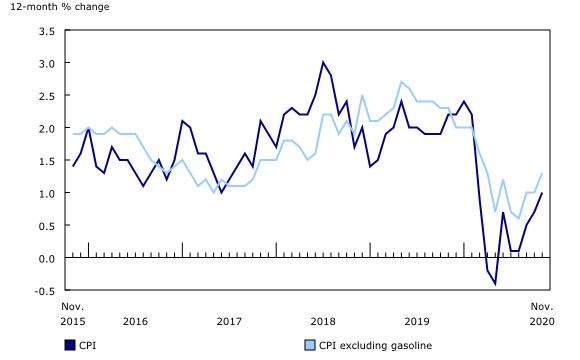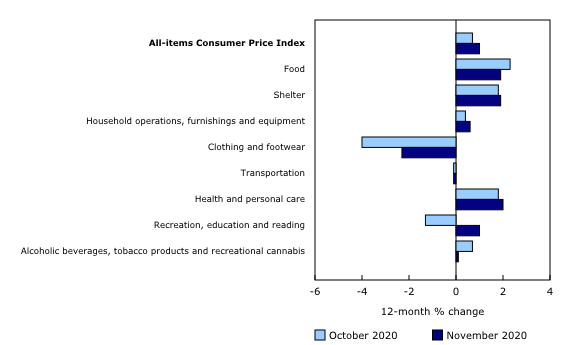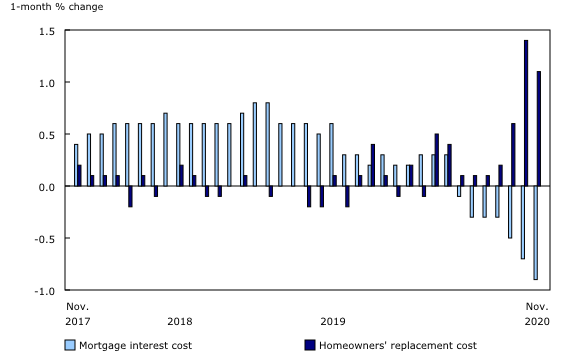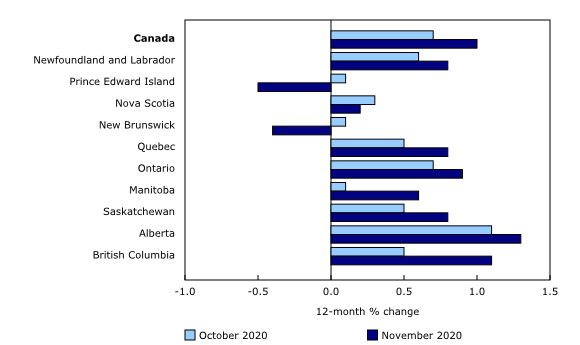Consumer Price Index, November 2020
Archived Content
Information identified as archived is provided for reference, research or recordkeeping purposes. It is not subject to the Government of Canada Web Standards and has not been altered or updated since it was archived. Please "contact us" to request a format other than those available.
Released: 2020-12-16
November 2020
1.0% 
(12-month change)
Year over year, the Consumer Price Index (CPI) rose at a faster pace in November (+1.0%) than in October (+0.7%), with shelter prices (+1.9%) contributing the most to the all-items increase. Excluding gasoline, the CPI rose 1.3% in November, up from a 1.0% increase in October.
On a seasonally adjusted monthly basis, the CPI rose 0.3% in November.
Explore the Consumer Price Index
Check out the new Personal Inflation Calculator! This interactive calculator allows you to enter dollar amounts in the common expense categories to produce a personalized inflation rate, which you can compare to the official measure of inflation that represents the average Canadian household—the Consumer Price Index (CPI).
Visit the Consumer Price Index portal to find all CPI data, publications, interactive tools, and announcements highlighting new products and upcoming changes to the CPI in one convenient location.
Check out the Consumer Price Index Data Visualization Tool to access current and historical CPI data in a customizable visual format.
Highlights
Prices rose in six of the eight major components on a year-over-year basis in November.
Although consumer confidence remains below pre-pandemic levels, increased consumer spending on household durable goods supported higher prices for furniture (+2.8%) and household appliances (+2.9%), which remain above pre-pandemic levels. As the household savings rate declined compared with the early months of the pandemic, physical distancing rules encouraging Canadians to stay home may have prompted increased spending on big-ticket items for the home.
Rent prices rise year over year
Rent prices rose 1.5% in the 12 months to November, up from a 1.0% increase in October.
While year-over-year growth in rent prices remained below pre-pandemic levels, November marked the fifth month-over-month increase in six months, with the lone decrease occurring in July.
Homeowners' replacement cost rises, while mortgage interest cost falls
The homeowners' replacement cost index, which is linked to the price of new homes, rose 1.1% month over month in November, the ninth consecutive monthly increase. Historically low interest rates coupled with a shift in home buyer preferences toward larger spaces continued to fuel demand for single-family homes. This higher demand and the combination of higher building material costs and low inventory of homes for sale in some markets contributed to rising prices for new housing.
The mortgage interest cost index fell 0.9% on a month-over-month basis in November, following a 0.7% decline in October, which marked the seventh consecutive monthly decline and the largest decrease since February 1994. Lower interest rates following reductions to the Bank of Canada's policy interest rate in March continued to contribute to the decline in borrowing costs as more Canadians renewed mortgages at lower rates.
Gasoline prices remain low
Gasoline prices fell 11.9% year over year in November, with domestic and international demand remaining low. The tightening of public health restrictions in response to the second wave of COVID-19 continued to weigh on low global demand for gasoline.
Travel tours and COVID-19
As a result of international travel advisories, travel tours remained unavailable to consumers in November. A general imputation strategy for services not available to consumers resulted in prices for travel tours being replaced with an imputed movement from the all-items CPI. As a result of this treatment, the travel tours index, which is highly seasonal in nature, is up 18.0% compared with November 2019, when prices fell 11.0%. This seasonal decline, which typically follows a price increase related to travel during Thanksgiving and the fall reading week, was not observed in 2020 due to the unavailability of international travel tours, resulting in upward pressure on the index. As such, the interpretation of the 12-month price change indicator should be made with caution.
Regional highlights
Prices increased in eight provinces on a year-over-year basis in November. Gasoline prices in British Columbia fell less, on a year-over-year basis, in November (-12.3%) than in October (-18.0%). A price drop in November 2019, resulting from a surplus of fuel in the Pacific Northwest, no longer impacted the 12-month movement in November 2020. In contrast, consumer prices were down in New Brunswick (-0.4%) and Prince Edward Island (-0.5%), where furnace fuel oil is more commonly used. At the national level, prices for fuel oil and other fuels (-23.3%) were almost one-quarter lower this November than in November 2019.
Higher natural gas prices in Manitoba
Manitobans paid just over one-quarter more for natural gas (+26.7%) in November compared with the same month a year earlier. The increase primarily reflected the removal of temporary rate adjustments introduced in the province in November 2019. On a month-over-month basis, natural gas prices rose 17.5% in November compared with a decline of 20.7% in November 2019 when this subsidy was introduced.
Additional research related to COVID-19
For more information about the impact of COVID-19 on consumer spending, please consult our additional publications, which are available in the Prices Analytical Series (62F0014M):
Canadian Consumers Prepare for COVID-19 (released April 8)
Canadian Consumers Adapt to COVID-19: A Look at Canadian Grocery Sales up to April 11 (released May 11)
Adjusting the Consumer Price Index to the new spending realities during the pandemic (released October 8). Note that table 18-10-0263-01 (monthly adjusted price index, provisional) and table 18-10-0264-01 (monthly adjusted consumer expenditure basket weights) will be updated on January 12, 2021.
Note to readers
COVID-19 and the Consumer Price Index
Statistics Canada continues to monitor the impacts of the novel coronavirus (also known as COVID-19) on Canada's Consumer Price Index (CPI).
Goods and services in the CPI which were not available to consumers in November due to COVID-19 restrictions received special treatments, effectively removing their impact on the monthly CPI. The following sub-indexes were imputed from the monthly change in the All-items index: travel tours, components of spectator entertainment, recreational services, and some components of use of recreational facilities and services in some areas.
Due to new restrictions, the price indexes for beer served in licensed establishments, wine served in licensed establishments and liquor served in licensed establishments were imputed in Quebec, using the indexes to which consumers likely redirected their expenditures: beer purchased from stores, wine purchased from stores and liquor purchased from stores.
Consistent with previous months affected by the COVID-19 pandemic, prices for suspended flights are excluded from the November CPI calculation because passengers were ultimately unable to consume them. As a result, select sub-components of the air transportation index were imputed from the parent index (air transportation).
A document entitled Technical Supplement for the November 2020 Consumer Price Index is available in the Prices Analytical Series (62F0014M) publication, with further details on the imputations used to compile the November 2020 CPI.
Inter-city data tables
With this release, data on inter-city indexes of price differentials of consumer goods and services, appearing in data table 18-10-0003-01, have been updated to October 2019. This table includes spatial indexes that measure the price differentials across geographical locations (15 Canadian cities) at a given period of time known as the reference period. A document entitled Inter-city indexes of price differentials, of consumer goods and services provides further information on methodology.
This program is currently under review, which may impact the timing of the next release. For questions about this program, please contact us (statcan.cpddisseminationunit-dpcunitedediffusion.statcan@canada.ca).
Real-time data tables
Real-time data table 18-10-0259-01 will be updated on January 4, 2021. For more information, consult the document Real-time CANSIM tables.
Next release
The Consumer Price Index for December 2020, including the Consumer Price Index Annual Review, will be released on January 20, 2021.
Products
The "Consumer Price Index Data Visualization Tool" is available on the Statistics Canada website.
More information about the concepts and use of the Consumer Price Index (CPI) is available in The Canadian Consumer Price Index Reference Paper (62-553-X).
For information on the history of the CPI in Canada, consult the publication Exploring the First Century of Canada's Consumer Price Index (62-604-X).
Two videos, "An Overview of Canada's Consumer Price Index (CPI)" and "The Consumer Price Index and Your Experience of Price Change," are available on Statistics Canada's YouTube channel.
Contact information
For more information, or to enquire about the concepts, methods or data quality of this release, contact us (toll-free 1-800-263-1136; 514-283-8300; STATCAN.infostats-infostats.STATCAN@canada.ca) or Media Relations (613-951-4636; STATCAN.mediahotline-ligneinfomedias.STATCAN@canada.ca).
- Date modified:





